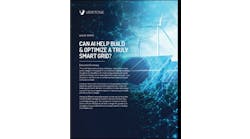Acknowledging that microgrids face tougher interconnection hurdles than other energy sources, California regulators are scheduled to take a vote that would push utilities to speed things up as wildfire season nears.
The California Public Utilities Commission plans to vote June 11 on a proposal that would require large electric investor-owned utilities open the way for developers to build more microgrids and resiliency projects — and do so fast.
The commission is eyeing with concern September 1, the traditional start of wildfire season, and trying to minimize the chaos that ensued last year when utilities shut off power to customers to avoid sparking fires, in a practice known as public safety power shutoffs (PSPS).
“Wildfire season will begin soon and, if like last year, it will surge this fall, bringing public safety power shut-offs and other outages” said Genevieve Shiroma, CPUC Commissioner. “Microgrids using independent energy supply can provide essential backup and resiliency for communities affected.”
The proposed decision marks action on ‘Track 1’ of a proceeding launched in October under a legislative directive (SB 1339) that the state support microgrid development. The first track focuses on securing microgrids and resiliency as soon as possible. Later tracks will deal with more complex issues.
Even before the wildfires boosted the value proposition for microgrids in California, the state was one of the nation’s most active markets for the technology, aided by an infusion of public funds for model demonstration projects. So not surprisingly participation in the microgrid proceeding has been robust with about 50 entities providing feedback to the commission.
Microgrids can be built more quickly
Microgrid developers have argued that they can now build microgrids quickly — with some simple microgrids erected in a matter of days and more complex microgrids months. But delays in interconnection and other red tape keep the projects from going into operation in a timely manner.
“There are simple modularized microgrids that are ready for deployment…with regulatory attention and aid, these microgrids could be deployed in a much more time efficient and cost-effective manner at a much larger scale,” Scale Microgrid said in comments it filed with the commission.
Learn more about microgrids in California at the Microgrid Knowledge Virtual Conference. Register for the free session, Navigating Dual Disasters: What are the Next Steps for California as it Emerges Out of Covid-19 and into Wildfire Season?
The proposal to be considered June 11 calls on utilities to improve the interconnection process in several ways, among them:
- Developing and implement standardized, pre-approved system designs for interconnection of resiliency projects that deliver energy services during grid outages
- Developing and implementing methods to increase simplicity and transparency of the processes by which the utilities inspect and approve a project
- Prioritize interconnection of resiliency projects for key locations, facilities or customers
The document recommends utilities undertake various practices, such as virtual inspections, eliminating duplication, publication of pre-approved templates, and use of smart meters for electrical isolation.
In addition to calling for interconnection changes, the proposed decision recommends approval by the commission of microgrid development plans by Pacific Gas and Electric (PG&E) and San Diego Gas & Electric.
One-year limit on diesel fuel
The utility plans include a controversial strategy put forward by PG&E to use temporary microgrids that run on diesel fuel for the upcoming wildfire season. The utility had originally planned to build permanent microgrids for this year, but said it ran out of time, so will pursue them over the next couple of years.
For this year, PG&E plans to lease 300 MW of diesel generators at a cost of $94 million. The proposed decision calls for the commission to approve the plan but with the cavaet that the utility use the generators for only one year.
“It is not a long-term resiliency strategy. Indeed, large diesel generators — even when localized in select areas — present potential health risks for individuals who live or work near a temporary generation site,” the proposed decision says.At the same time the commission needs to weigh potential for “loss of, or damage to, life, health, property, or essential public service,” from power outages.
The proposed decision also calls for changing net metering tariffs so that they account for the resilience value of energy storage. Storage devices would be able to charge from the grid during the pre-public safety power shut off window. The change also would remove storage sizing limits.
And last, the proposal adopts solutions that promote collaboration between utilities and local and tribal governments to foster microgrids.
The proposed decision is available on the commission website.
Subscribe to the free Microgrid Knowledge newseltter for more on California microgrids.







